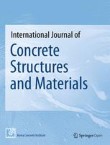International Journal of Concrete Structures and Materials is affiliated with Korea Concrete Institute.
FRP Confinement of Heat-Damaged Circular RC Columns
To investigate the effectiveness of using fiber reinforced polymer (FRP) sheets in confining heat-damaged columns, 15 circular RC column specimens were tested under axial compression. The effects of heating du...
